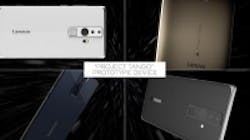Lenovo to produce first OEM Google Project Tango device
The rumors about a major announcement fromGoogle and Lenovo at CES 2016 were true, as the two companies will collaborate on the development of the first Project Tango-enabled smartphone.
MORE ARTICLES
Google and Movidius partner to accelerate machine learning in mobile devices
Set to become available in the summer of 2016, the smartphone will be powered by the Qualcomm Snapdragon processor and will feature a screen that acts as a "magic window that can overlay digital information and objects onto the real world." Lenovo, Google, and Qualcomm Technologies are all collaborating to optimize the software and hardware.
Google’s Project Tango is a technology platform that uses advanced computer vision, depth sensing, and motion tracking to create on-screen 3D experiences, allowing users to explore their physical environments via their device. The device reacts to every movement of the user, and app developers, according to Lenovo, can transform their home into a game level, or create a magic window into virtual and augmented environments. The device will even recognize places it has been before, and unlike GPS, has motion tracking that also works indoors.
"With Project Tango, the smartphone becomes a magic window into the physical world by enabling it to perceive space and motion that goes beyond the boundaries of a touch screen," said Johnny Lee, Project Tango Lead, Google. "By working with Lenovo, we’ll be able to make Project Tango more accessible to users and developers all over the world to both enjoy and create new experiences that blends the virtual and real world."
The Tango device features OV4682 and OV7251 CMOS image sensors from OmniVision Technologies. The OV4682 records both RGB and IR information, the latter of which is used for depth analysis. The 1/3in, 4 MPixel color sensor features a 2 µm pixel size, a frame rate of 90 fps at full resolution and 330 fps at 672 x 380 pixels.
The OV7251 global shutter image sensor is used for the device’s motion tracking and orientation. The 1/7.5in VGA OV7251 sensor features a 2 µm pixel size and a frame rate of 100 fps. Both sensors feature programmable controls for frame rate, mirror and flip, cropping, and windowing. In addition, the Myriad 1 computer vision processor from Movidius helps to process data for the Tango device.
Google and Lenovo are currently inviting developers to help grow the Project Tango app ecosystem by submitting app proposals for a chance to win funding and the chance to have their app featured on Lenovo’s upcoming smartphone. Submissions will be accepted until February 15, 2016.
View more information on theproject.
View more information on the app incubator.
Share your vision-related news by contactingJames Carroll, Senior Web Editor, Vision Systems Design
To receive news like this in your inbox,click here
Join ourLinkedIn group | Like us on Facebook | Follow us on Twitter
About the Author

James Carroll
Former VSD Editor James Carroll joined the team 2013. Carroll covered machine vision and imaging from numerous angles, including application stories, industry news, market updates, and new products. In addition to writing and editing articles, Carroll managed the Innovators Awards program and webcasts.
